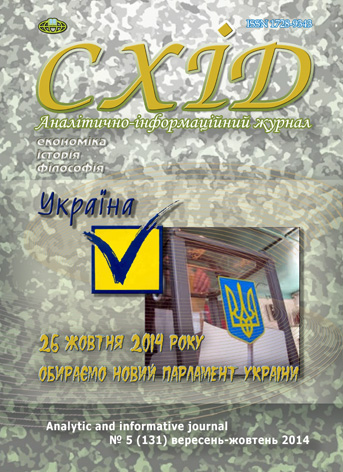Laughter as a factor in the development of national socio-cultural identity of Ukrainian Cossacks
DOI:
https://doi.org/10.21847/1728-9343.2014.5(131).29625Keywords:
laughter, social functions of laughter, Ukrainian Cossackdom, marginality, liminal community, "boundary situation", "borderline being", trickster myth, national sociocultural identity, the Ukrainian national character, mentalityAbstract
The article defines preconditions, causes, and mechanisms of laughter functioning and elucidates consequences of its activation as an influential factor in the formation of national cultural and social identity of Ukrainian Cossacks. It is proved that being engraved in the Cossacks' identity, their propensity to cheerful disposition, audacious sense of humour, and life-affirming laughter acquired the status of distinguishing features of Ukrainian national character. They become especially topical in crisis and transition conditions of sociocultural development.
The work ascertains that the Zaporozhian Cossacks became the exponent of Ukrainian spirit because in transition times of history, only such a liminal community could represent our people whose eternal destiny is to live "at the brink" and "on the edge". National sociocultural identification of the Cossacks is directly linked to conditions of "metaboundary state" or "transition", which are generally accompanied by the revival of trickster myths and marked by the proliferation of carnavalized actions, antibehavior, and comic reaction as a spontaneous, uncontrolled, and unconscious response to multiple challenges of the external environment and their deep inner spiritual world. Laughter acts as a multifunctional and polysemous factor, an unconscious instrument of social and psychological distance whose poles are identification or rejection.
Obtained results testify to controversial sociocultural dynamics of laughter, which can manifest features of chaotized cosmos in crises, not only demonstrating destructive potencies aimed at universal chaotization of society and rejection of established norms and rules but also transforming the chaos into the fertile ground, where a new order is constructed and values of the new cosmos are sacralized despite the threat of critical disaster, nonexistence, and reappraisal of values. Today, when the Ukrainians are at the new stage of their national liberation movement and a sense of perplexity is spreading in them, the Cossacks' identity characterized by specific desire for freedom, truth, social justice, trickster spirit, and rampancy of comic elements is steadily reviving. Greeting principles of laughter are used as a well-tried remedy for self-identity, self-esteem, and struggle against those perceived as enemies.Downloads
References
Fedenko, P. (1942), "History Impacts on Ukrainian National Identity", Academic Collection of Prague Ukrainian Free University, Vol. 3, pp. 375-385 (ukr).
Kravchenko I., compiler texts (1993), Zaporozhtsi: The history of Cossack culture, Mystetstvo, Kyiv, 400 p. (ukr).
Mid, M. (2008), The Culture and World of Childhood, Moscow, pp. 278-289 (rus).
Kostomarov, N. (1990), Historical Monographs and Studies, Kniga, Moscow, 236 p. (rus).
Van Gennep, A. (1999), The Rites of Passage, Vostochnaia Literatura, Moscow, 198 p. (rus).
Terner, V. (1983), Symbol and Ritual, Nauka, Moscow, 278 p. (rus).
Jung, C. (2004), Archetypes and Collective Unconscious, Harvest, Minsk, pp. 338-358 (rus).
Radin, P. (1998), The Trickster: A Study in Native American Mythology with Comments of Jung and Kereni, Eurasia, Saint Petersburg, 288 p. (rus).
Kerenyi, K. (1999), Trickster and Ancient Greek Mythology, in Radin, P., The Trickster: A Study in Native American Mythology with Comments of Jung and Kereni, Eurasia, Saint Petersburg, pp. 242-264 (rus).
Lеvi-Strauss, C. (2011), Structural Anthropology, Mocsow, 544 p. (rus).
Jung, C. (1994), Jung on Modern Myths, Praktika, Minsk, 210 p. (rus).
Popovych, M. (1999), The Cossacks as a Cultural Phenomenon, Kyiv, pp. 159-170 (ukr).
Balushok, V. (1994), "Initiations of Zaporozhian Cossacks", Sich, Vol. 6, pp. 69-76 (ukr).
Hrushevskyi, M. (1996), History of Ukraine - Russia, Naukova Dumka, Kyiv, VII, pp. 376-389 (ukr).
Yakovenko, N. (2002), Parallel World. Research on the History of Concepts and Ideas in Ukraine in XVI-XVII Centuries, Kyiv, 415 p. (ukr).
Maltseva O. (2014), Social Functions of Laughter in Liminary Rites: Initiation, in The Book of Abstracts of The International Scientific and Technical Conference "University Science - 2014", Pryazovskyi State Technical University, Mariupol, pp. 178-179 (ukr).
Holobutskyi, V. (2003), Leden, Leden in the leafy forest, Dnipropetrovsk, 208 p. (ukr).
Yarema, Y. (1935), Ukrainian Spirituality in Its cultural and Historical Manifestations, Ridna Shkola, Lviv, pp. 16-18 (ukr).
Kornev, A. (2006), "Correspondence of Cossack Leaders with Polish Magnates in Khmelnitsky Era in the Context of Laugh Culture", Bulletin of Kharkiv State Academy of Design and Arts, Vol. 3, pp. 77-82 (ukr).
Propp, V. (2002), Problems of Humour and Laughter, Labirint, Moscow, p. 189 (rus).
Sikevich, Z., Krokinskaia, O. and Possel, Y. (2005), Social Irrationality, Piter, Saint Petersburg, 267 p. (rus).
Downloads
Published
How to Cite
Issue
Section
License
Copyright (c) 2014 Olha Maltseva

This work is licensed under a Creative Commons Attribution-NonCommercial-NoDerivatives 4.0 International License.
1. Authors bear responsibility for the accuracy of facts, quotations, numbers and names used.
2. Manuscripts are not sent back.
3. The publisher does not always agree with the authors' opinion.
4. The authors reserve the right to authorship of the work and pass the first publication right of this work to the journal under the terms of a Creative Commons Attribution-NonCommercial-NoDerivatives 4.0 International License. This license allows others to distribute (copy) the published work for non-commercial purposes, provided there is mandatory attribution to its authors and a link to the first publication in our journal.
5. The authors have the right to conclude separate supplement agreements that relate to non-exclusive work distribution in the form in which it has been published by the journal (for example, to upload the work to the online storage of the journal or publish it as part of a monograph), provided that the reference to the first publication of the work in this journal is included.

